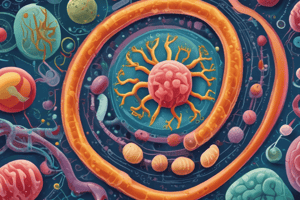Podcast
Questions and Answers
What are the two most potent drugs to which the organisms responsible for multidrug resistant tuberculosis are resistant?
What are the two most potent drugs to which the organisms responsible for multidrug resistant tuberculosis are resistant?
What is the primary risk factor for developing MDR - TB?
What is the primary risk factor for developing MDR - TB?
How can healthcare providers effectively prevent MDR - TB?
How can healthcare providers effectively prevent MDR - TB?
Which group is recommended to receive chemoprophylaxis if they are household contacts to a case of pulmonary tuberculosis?
Which group is recommended to receive chemoprophylaxis if they are household contacts to a case of pulmonary tuberculosis?
Signup and view all the answers
What measure is crucial for the prevention of MDR - TB?
What measure is crucial for the prevention of MDR - TB?
Signup and view all the answers
What percentage of MDR - TB cases is estimated to be extensively drug resistant tuberculosis (XDR - TB)?
What percentage of MDR - TB cases is estimated to be extensively drug resistant tuberculosis (XDR - TB)?
Signup and view all the answers
What factor can contribute to a patient's poor compliance with tuberculosis medication?
What factor can contribute to a patient's poor compliance with tuberculosis medication?
Signup and view all the answers
Study Notes
Multidrug-Resistant Tuberculosis (MDR-TB)
- MDR-TB is a strain of TB resistant to at least isoniazid and rifampin, the most potent drugs.
- In 2015, an estimated 480,000 people globally developed MDR-TB, with an additional 100,000 with rifampin-resistant TB becoming eligible for MDR-TB treatment.
- India, China, and Russia accounted for 45% of these 580,000 cases.
- Roughly 9.5% of these cases were extensively drug-resistant tuberculosis (XDR-TB). XDR-TB is a rare type of MDR-TB resistant to isoniazid and rifampin, plus any fluoroquinolone and at least one of three injectable second-line drugs (amikacin, kanamycin, or capreomycin).
Risk Factors for MDR-TB
- Patients who do not consistently take their anti-TB medications as prescribed.
- Patients who have had TB in the past and have relapsed.
- Those from regions with high prevalence of drug-resistant TB.
- People who have been exposed to individuals with drug-resistant TB.
Preventing MDR-TB
- Adherence to the prescribed treatment regimen is crucial to prevent the spread of MDR-TB.
- Patients should discuss any difficulties with treatment, such as side effects, cost, or unavailability of medications, with their physician.
- Healthcare providers should swiftly diagnose cases, follow treatment guidelines, and monitor patient adherence and response.
- Avoiding exposure to known MDR-TB patients in closed or crowded settings (hospitals, prisons, shelters) can also prevent infection.
Child Contacts of TB Cases
- Children under 5 years old who are household contacts of TB cases and do not show active TB symptoms should receive preventive treatment (chemoprophylaxis) as per the algorithm in Figure 5.
Studying That Suits You
Use AI to generate personalized quizzes and flashcards to suit your learning preferences.
Description
This quiz covers the essentials of Multidrug-Resistant Tuberculosis (MDR-TB), including its definitions, global statistics, and risk factors. Learn how to prevent MDR-TB, and understand the significance of adherence to treatment. Test your knowledge on this serious public health issue.




